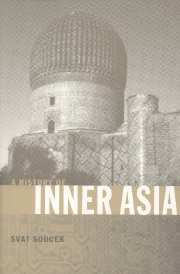Book contents
- Frontmatter
- Contents
- List of maps
- Preface
- Introduction
- 1 The beginnings
- 2 The Kök Turks, the Chinese expansion, and the Arab conquest
- 3 The Samanids
- 4 The Uighur kingdom of Qocho
- 5 The Qarakhanids
- 6 Seljukids and Ghaznavids
- 7 The conquering Mongols
- 8 The Chaghatayids
- 9 Timur and the Timurids
- 10 The last Timurids and the first Uzbeks
- 11 The Shaybanids
- 12 The rise of Russia, the fall of the Golden Horde, and the resilient Chaghatayids
- 13 The Buddhist Mongols
- 14 Bukhara, Khiva, and Khoqand in the seventeenth to nineteenth centuries
- 15 The Russian conquest and rule of Central Asia
- 16 From Governorates-General to Union Republics
- 17 Soviet Central Asia
- 18 Central Asia becomes independent
- 19 Sinkiang as part of China
- 20 Independent Central Asian Republics
- 21 The Republic of Mongolia
- Summary and conclusion
- Appendix 1 Dynastic tables
- Appendix 2 Country data
- Select bibliography
- Index
1 - The beginnings
Published online by Cambridge University Press: 05 June 2012
- Frontmatter
- Contents
- List of maps
- Preface
- Introduction
- 1 The beginnings
- 2 The Kök Turks, the Chinese expansion, and the Arab conquest
- 3 The Samanids
- 4 The Uighur kingdom of Qocho
- 5 The Qarakhanids
- 6 Seljukids and Ghaznavids
- 7 The conquering Mongols
- 8 The Chaghatayids
- 9 Timur and the Timurids
- 10 The last Timurids and the first Uzbeks
- 11 The Shaybanids
- 12 The rise of Russia, the fall of the Golden Horde, and the resilient Chaghatayids
- 13 The Buddhist Mongols
- 14 Bukhara, Khiva, and Khoqand in the seventeenth to nineteenth centuries
- 15 The Russian conquest and rule of Central Asia
- 16 From Governorates-General to Union Republics
- 17 Soviet Central Asia
- 18 Central Asia becomes independent
- 19 Sinkiang as part of China
- 20 Independent Central Asian Republics
- 21 The Republic of Mongolia
- Summary and conclusion
- Appendix 1 Dynastic tables
- Appendix 2 Country data
- Select bibliography
- Index
Summary
To most contemporaries, the year 622 must have appeared fairly ordinary. No great battle or upheaval took place. The principal empires of the time – Tang China, Sasanian Iran, and Heraclian Byzantium – were busy building up their strength, recovering from recent confrontations, or preparing for new ones; and the petty princes of Transoxania were content in their prosperous though diminutive domains, while recognizing, when necessary, the suzerainty of the nomadic Turks, whose empire stretched along a long swath of Inner Asia from China's northern frontiers to the Caspian steppes. Meanwhile Sogdian and other merchants of the Silk Road trade kept criss-crossing Central Asia, as they had done since antiquity and would continue doing until the end of the Middle Ages.
China, Iran, and Byzantium were ancient empires with civilizations and records older than their ruling dynasties. The Turks, on the other hand, had established their qaghanate only recently, in the middle of the sixth century, and never raised it above the fragile and ephemeral existence characteristic of most nomadic empires. Known in modern historiography as the empire of the Kök Turks or Tu-chüeh or Türk empire, it lasted from 552 to 744. Its territory stretched along a rather narrow latitudinal steppe belt interrupted or fringed by mountain chains dominated by the Altai and Tianshan ranges. The geopolitical peculiarity of this formation may have played an additional role in the characteristic tendency of a Turkic state to split up into two branches, a senior and a junior one.
- Type
- Chapter
- Information
- A History of Inner Asia , pp. 46 - 50Publisher: Cambridge University PressPrint publication year: 2000

